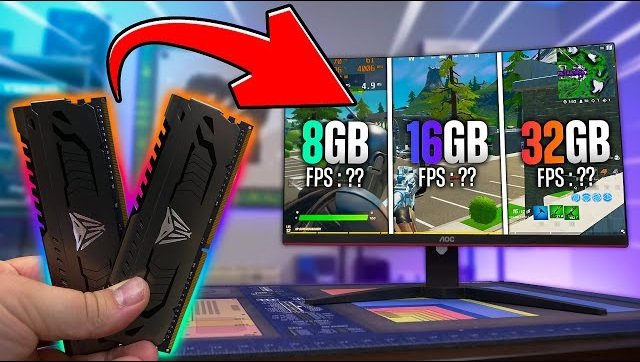RAM (Random Access Memory) plays a crucial role in determining how fast and smoothly your computer runs. But how much RAM do you really need? In this article, we’ll break down the importance of RAM, explain how it impacts different types of users, and help you figure out the right amount of RAM for your needs.
What is RAM?
RAM, or Random Access Memory, is the short-term memory of your computer. It temporarily stores data that your computer is actively using, allowing quick access to applications and processes. Think of RAM as your computer’s “workspace.” The more RAM you have, the more tasks your computer can handle at once, making multitasking smoother and faster.
While storage (like your hard drive or SSD) permanently stores files and programs, RAM is more like a temporary workspace where active tasks are stored. Once you shut down your computer, everything in RAM is wiped clean.
Why RAM is Important
RAM is essential for the speed and efficiency of your computer. It allows your machine to process tasks faster by making frequently accessed data readily available. Without enough RAM, your system may struggle to keep up, leading to slowdowns or crashes, especially when you’re running multiple programs.
For example, if you’re opening several browser tabs, editing a video, and running music software simultaneously, your computer will rely heavily on RAM to juggle these tasks. Insufficient RAM will cause your system to lag or freeze.
Factors to Consider When Choosing RAM
Before deciding how much RAM you need, it’s important to consider a few key factors:
- Type of Usage: What do you plan to use the computer for? Simple tasks like browsing the web and word processing need less RAM compared to tasks like video editing or gaming.
- Software: Some applications, such as Adobe Photoshop or video editing software, are RAM-intensive and require more memory to run smoothly.
- Operating System: Your OS (whether Windows, macOS, or Linux) has its own minimum RAM requirements.
How RAM Affects Different Types of Users
Casual Users
If you’re mostly browsing the web, checking email, streaming videos, and doing light word processing, you don’t need a lot of RAM. Most casual users can get by with 8GB of RAM, but 4GB might be enough for very basic tasks.
Gamers
Gamers typically need more RAM for modern, resource-heavy games. 16GB of RAM is usually the sweet spot for gaming. Having enough RAM ensures that the game loads quickly and doesn’t lag when you’re playing online or running multiple applications in the background, such as streaming on Twitch or Discord.
Creative Professionals
Graphic designers, video editors, and 3D animators require much more RAM. For example, rendering high-resolution videos or working on large graphics projects can consume a significant amount of memory. For these users, 16GB to 32GB of RAM is recommended to keep things running smoothly.
Developers
If you’re a programmer or developer, especially if you’re working with virtual machines or large datasets, more RAM is beneficial. Many developers find that 16GB to 32GB of RAM is optimal for running multiple programs simultaneously, including development environments, virtual machines, and browsers for testing.
Minimum RAM Requirements for Different Scenarios
4GB of RAM: Suitable for Basic Tasks
4GB is generally the bare minimum and is suitable for users who perform basic tasks like browsing the web, checking emails, or doing light word processing. However, even for casual users, 4GB is becoming less common due to modern applications requiring more memory.
8GB of RAM: The Standard for Most Users
8GB is the standard for most users today. It offers enough memory for daily multitasking, including web browsing, word processing, and running multiple programs without experiencing significant slowdowns.
16GB of RAM: For Gamers and Creative Professionals
For gamers and users who work with demanding applications, 16GB is the recommended minimum. It allows for smooth gaming experiences, faster loading times, and the ability to run several programs at once without crashing.
32GB of RAM: For Heavy Multitasking and Professionals
32GB of RAM is ideal for professionals who work with large files, such as video editors, animators, or software developers running virtual machines. This amount of memory ensures that everything runs smoothly, even during intensive workloads.
64GB+ of RAM: Specialized Use Cases
64GB or more is generally only necessary for niche use cases, such as scientific computing, machine learning, or working with massive databases. For the average user, this amount of RAM would be overkill.
How Much RAM Does Your Operating System Need?
Windows
Windows 10 and 11 require a minimum of 4GB of RAM to run, but for a smooth experience, especially with multitasking, 8GB is recommended. High-end applications, like video editing software, might push that to 16GB or more.
macOS
macOS runs well with 8GB of RAM for general use, but creative professionals using apps like Final Cut Pro or Logic Pro will benefit from having 16GB or more.
Linux
Linux is known for being lightweight, and many distributions can run smoothly with just 4GB of RAM. However, if you’re running more demanding applications or virtual machines, 8GB to 16GB is recommended.
Chrome OS
Chrome OS is designed to be lightweight and efficient, making it possible to run smoothly on just 4GB of RAM. However, if you use many web-based applications simultaneously, 8GB can provide a better experience.
How Much RAM Do You Need for Gaming?
Gaming performance can depend heavily on RAM, especially for modern games that require more memory to handle high-quality textures and fast loading times. For most gamers, 16GB of RAM is more than enough to run most AAA titles. If you’re a competitive gamer or someone who streams while gaming, 16GB is ideal.
How Much RAM Do You Need for Creative Work?
Creative professionals, such as video editors and graphic designers, often work with large files and memory-hungry software. Adobe Premiere, Photoshop, and other creative tools require at least 16GB of RAM for smooth operation. For those working on high-resolution video editing or 3D modeling, 32GB of RAM can prevent crashes and slowdowns.
How Much RAM Do You Need for Multitasking?
If you frequently run multiple applications at once, such as browsing with many tabs, editing documents, and using messaging apps, 16GB of RAM should be sufficient. However, for extreme multitasking, like using virtual machines or multiple development tools simultaneously, 32GB or more may be beneficial.
Can You Have Too Much RAM?
While more RAM can improve performance, there is a point of diminishing returns. Most users won’t see any benefit
from having more than 32GB of RAM, and for many, even 16GB will be more than enough. The cost of extra RAM might not be justified unless you have specific needs like professional video editing, running virtual machines, or data-intensive computing.
How to Check Your Current RAM Usage
If you’re unsure how much RAM your computer is currently using, both Windows and macOS offer built-in tools to check:
- Windows: Use Task Manager (Ctrl + Shift + Esc) to monitor your memory usage in real-time.
- macOS: Open Activity Monitor to check how much RAM is being used.
Upgrading Your RAM
For most desktop computers, upgrading RAM is straightforward. You can usually add or replace the RAM modules yourself. However, many modern laptops, particularly ultrabooks, have soldered RAM, meaning it can’t be upgraded. Always check your device’s specs before purchasing more RAM.
Conclusion
How much RAM you need depends on what you plan to use your computer for. For most users, 8GB is the standard, providing a smooth experience for daily tasks. Gamers, creative professionals, and those who do heavy multitasking should consider 16GB or more. Always consider your specific needs and future-proofing when deciding how much RAM to invest in.
FAQs
1. How can I check how much RAM I have?
You can check your RAM by opening Task Manager (Windows) or Activity Monitor (macOS) and viewing the system information.
2. Is 8GB of RAM enough for gaming?
Yes, 8GB of RAM is sufficient for many games, but 16GB is recommended for a better overall gaming experience, especially for newer titles.
3. Can I add more RAM to my computer?
Yes, most desktops allow for RAM upgrades, but many modern laptops have non-upgradable, soldered RAM, so check your device’s specifications first.
4. Does RAM affect the speed of my computer?
Yes, RAM directly affects your computer’s speed, particularly when multitasking or running memory-intensive applications.
5. Can too much RAM slow down my computer?
No, having more RAM than needed won’t slow down your computer, but it may not offer any noticeable performance benefits beyond a certain point.





Leave a Reply